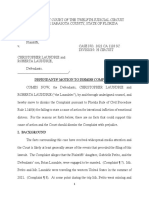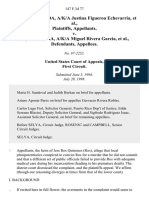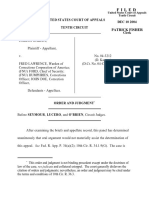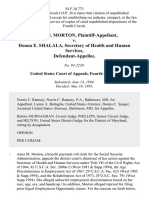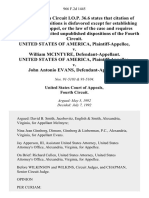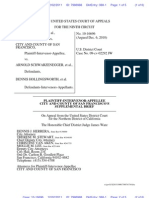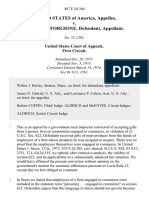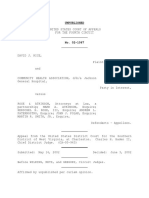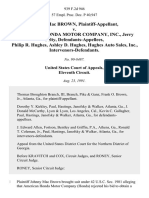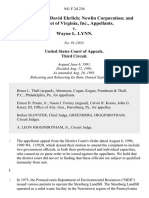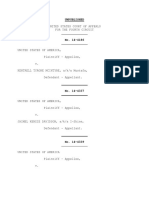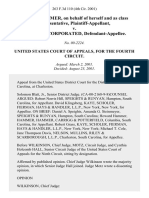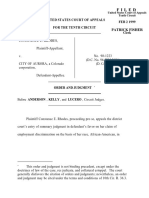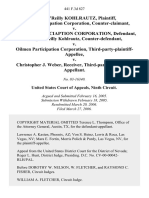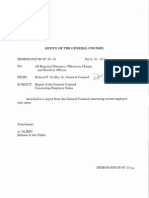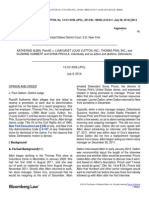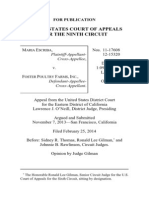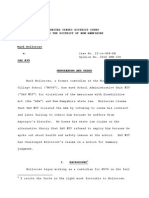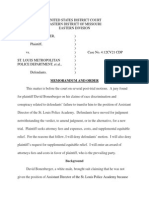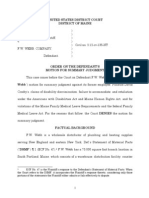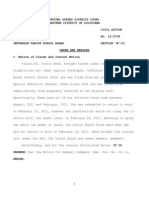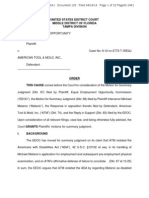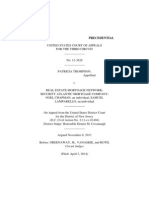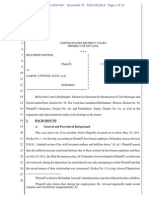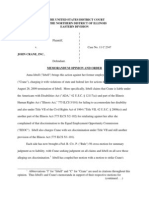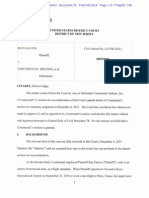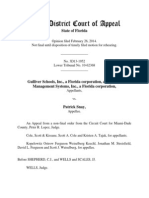Professional Documents
Culture Documents
MIRIAM M. GARZA v. RANIER L.L.C., Et Al.
Uploaded by
Eric MeyerOriginal Title
Copyright
Available Formats
Share this document
Did you find this document useful?
Is this content inappropriate?
Report this DocumentCopyright:
Available Formats
MIRIAM M. GARZA v. RANIER L.L.C., Et Al.
Uploaded by
Eric MeyerCopyright:
Available Formats
Case 1:12-cv-00475-AWA Document 26 Filed 07/31/13 Page 1 of 11
IN THE UNITED STATES DISTRICT COURT FOR THE WESTERN DISTRICT OF TEXAS AUSTIN DIVISION ORDER
Before the Court are: Defendants Opposed Motion for Summary Judgment (Dkt. No. 17); Plaintiffs Response (Dkt. No. 18); and Defendants Reply (Dkt. No. 19). The parties have consented to proceed in this case before the undersigned magistrate judge.
MIRIAM M. GARZA v. RANIER L.L.C., et al.
A-12-CV-475-AWA
I.
Factual Background
Plaintiff Miriam M. Garza (Garza or Plaintiff) is a Mexican American female. Plaintiffs Original Complaint at p. 4. Plaintiff was employed by Ranier Management, Ltd.1 (Ranier) beginning in January 2008. Ranier manages seventeen multi-family apartment communities in Austin, Texas. Affidavit of Kathy Hull at p. 1. Garza began her employment with Ranier as a property manager in charge of an individual property. Id. at p. 2. Subsequently, she was promoted to an area manager position in charge of multiple properties. Id. at p. 2-3. During her three-year employment with Ranier, Garza received raises and was promoted. Id. at p. 3. She also received two written warnings for failure to follow company policy one in 2008 and one in 2010. Id. On February 10, 2011, Garzas supervisors, Kathy Hull and Dawn Mooty, conducted a performance review of Garza. Exhibit 12 to Garza Deposition. After the performance review, Mooty prepared a summary of Garzas performance issues highlighting various areas of weakness. Affidavit of Kathy Hull at p. 4. Garza alleges that in June of 2011, Hull informed Garza that Garzas management style
Ranier LLC is the general partner of Ranier Management, Ltd. Factual Appendix at p. 1.
Case 1:12-cv-00475-AWA Document 26 Filed 07/31/13 Page 2 of 11
was ghetto. Plaintiffs Original Complaint at p. 4. On August 8, 2011, Ranier alleges that Hull addressed Garza regarding several issues including: her use of Facebook during office hours; the quality of apartment make-readies; open work orders for apartments; inordinate overtime by Garzas employees; and failing to enforce company policies with her staff regarding personal calls and Facebook. Id. at p. 5. Hull acknowledges in her Affidavit that I advised Ms. Garza that this ghetto-ness would no longer be tolerated, and that she would be terminated if it continued. Id. On August 29, 2011, Hull discovered that Garza had posted a deposit to the incorrect apartment and refunded it to the wrong tenant, along with the deposit actually paid by that tenant. Id. at p. 6. Garza was terminated on August 29, 2011. Id. Garzas Employee Termination Report, under a section entitled Prior discussion or warnings on this subject, whether oral or written: states 08/08/2011 Miriam was spoken to about being on Face book during working hours and the ghetto-ness going on in her office would not be tolerated anymore. Exhibit 2 to Plaintiffs Response. On January 19, 2012, Garza filed a Complaint with the EEOC alleging discrimination based upon race and national origin. On March 5, 2012, Garza received a right to sue letter from the EEOC. She filed the instant suit on June 1, 2012, alleging violations of Title VII of the Civil Rights Act of 1964 (Count One) and 42 U.S.C. 1981 (Count Two). II. Summary Judgment Standard Summary judgment shall be rendered when the pleadings, the discovery and disclosure materials on file, and any affidavits show that there is no genuine dispute as to any material fact and that the moving party is entitled to judgment as a matter of law. FED . R. CIV . P. 56(a); Celotex Corp. v. Catrett, 477 U.S. 317, 32325 (1986); Washburn v. Harvey, 504 F.3d 505, 508 (5th Cir. 2007). A dispute regarding a material fact is genuine if the evidence is such that a reasonable jury could return a verdict in favor of the nonmoving party. Anderson v. Liberty Lobby, Inc., 477 U.S. 242, 248 (1986). When ruling on a motion for summary judgment, the court is required to view all inferences 2
Case 1:12-cv-00475-AWA Document 26 Filed 07/31/13 Page 3 of 11
drawn from the factual record in the light most favorable to the nonmoving party. Matsushita Elec. Indus. Co. v. Zenith Radio, 475 U.S. 574, 587 (1986); Washburn, 504 F.3d at 508. Further, a court may not make credibility determinations or weigh the evidence in ruling on a motion for summary judgment. Reeves v. Sanderson Plumbing Prods., Inc., 530 U.S. 133, 150 (2000); Anderson, 477 U.S. at 25455. Once the moving party establishes that there are no factual issues, the burden shifts to the nonmoving party to produce evidence that a genuine issue of material fact exists for trial. The nonmoving party must then go beyond the pleadings, and by affidavits or other competent summary judgment evidence cite specific facts that show there is a genuine issue for trial. Celotex Corp., 477 U.S. at 324. But a district court may not grant a motion for summary judgment merely because it is unopposed. Hibernia Natl Bank v. Administracion Cent. Sociedad Anonima, 776 F.2d 1277, 1279 (5th Cir. 1985). III. Analysis Defendant Ranier moves for summary judgment on Garzas claims.2 Title VII of the Civil Rights Act of 1964, 42 U.S.C. 2000e2(a), makes it unlawful for an employer to discriminate against an employee based on the individuals race, color, religion, sex, or national origin. Intentional discrimination can be proven by either direct or circumstantial evidence. Russell v. McKinney Hosp. Venture, 235 F.3d 219, 222 (5th Cir. 2000). The Courts analysis, and the burdens at the summary judgment stage, differs when there is direct evidence of a discriminatory intent from when there is only circumstantial evidence of discrimination. When the summary judgment record contains direct
The analysis under Title VII and 1981 are identical, Raggs v. Mississippi Power & Light Co., 278 F.3d 463, 468 (5th Cir. 2002), the only substantive differences between the two statutes being their respective statute of limitations and the requirement under Title VII that the employee exhaust administrative remedies. See Celestine v. Petroleos de Venezuella SA, 266 F.3d 343, 351 (5th Cir. 2001). 3
Case 1:12-cv-00475-AWA Document 26 Filed 07/31/13 Page 4 of 11
evidence or discrimination, the burden shifts to the employer to show that the same decision would have been made even had there been no discriminatory motive. Jones v. Robinson Prop. Group,
427 F.3d 987, 992 (5th Cir. 2005). On the other hand, if there is only circumstantial evidence to support the claimas is the case in the vast majority of Title VII casesthe case is analyzed according to the burden-shifting framework established by the Supreme Court in McDonnell Douglas Corp. v. Green, 411 U.S. 792, 802 (1973). A. Plaintiffs Claim of Direct Evidence of Discrimination Direct evidence is evidence, which if believed, proves the fact in question without inference or presumption. Jones, 427 F.3d at 992. Garza asserts that Kathy Hulls statement in her Employee Termination Report that Garzas ghetto-ness would not be tolerated anymore qualifies as direct evidence of Raniers discrimination. To be direct evidence, a remark must be (1) related to the protected class of persons of which the plaintiff is a member, (2) proximate in time to the employment decision, (3) made by an individual with authority over the employment decision at issue, and (4) related to the employment decision at issue. Reilly v. TXU Corp., 271 F. Appx 375, 379 (5th Cir. 2008) (citing Auguster v. Vermilion Parish Sch. Bd., 249 F.3d 400, 405 (5th Cir. 2001)). In this case, the parties dispute only the first factor of the four-part testwhether the remark was related to the protected class of persons of which the plaintiff is a member. See Jenkins v. Methodist Hosps. of Dallas, Inc., 478 F.3d 255, 261 (5th Cir. 2007). Ranier argues that in order for a protected-class based comment to be probative of an employers discriminatory intent, it must be direct and unambiguous, allowing a reasonable jury to conclude without any inferences or presumptions that the employees protected class was a determinative factor in the decision to terminate the employee. Defendants Opposed Motion for Summary Judgment at p. 4. Ranier relies on various cases in support of this statement. Moss v. BMC Software, Inc., 610 F.3d 917, 929 (5th
Case 1:12-cv-00475-AWA Document 26 Filed 07/31/13 Page 5 of 11
Cir. 2010); Wallace v. Methodist Hosp. Sys., 271 F.3d 212, 222 (5th Cir. 2001) (citing Wyvill v. United Cas. Life Ins. Co., 212 F.3d 296, 303 (5th Cir. 2000)). Ranier asserts that the statement contained in the Termination Report that the ghetto-ness going on in Garzas office would not be tolerated anymore and the previous comment that Garzas management style was ghetto referred not to Garzas race, but to the rundown appearance of the properties Garza managed. Ranier asserts that ghetto refers to residential areas that are rundown and trash-strewn. Ranier also notes that cases in which comments containing the word ghetto have been viewed as facially discriminatory generally involve African American employees, while Garza is Hispanic.3 See, e.g., Harrington v. Disney Regl Entmt, Inc., 276 F. Appx 863 (11th Cir. 2007); Turner v. Baylor Richardson Med. Ctr., 476 F.3d 337 (5th Cir 2007); Spears v. Patterson UTI Drilling Co., 337 F. Appx 416, 2009 WL 2134601 (5th Cir. 2009); Williams v. Taco Bell, 46 F. Appx 732, 2002 WL 1973807 (5th Cir. 2002); Green v. Harris Publns, Inc., 331 F. Supp. 2d 180, (S.D.N.Y. 2004); Harris v. Wackenhut Servs., Inc., 648 F. Supp. 2d 53, (D. D.C. 2009). Thus, Ranier argues, because the statements by Hull are not direct and unambiguous they are insufficient to support a direct evidence case. Garza, of course, disagrees. Garza asserts that the term ghetto was used as a personal reference to her and not to the properties she managed. Garza points out that on the Termination Report the comment is the ghetto-ness going on in Garzas office would not be tolerated anymore. Additionally, Garza maintains, Ranier has failed to establish as a matter of law that Hulls use of the term ghetto was not a racial comment directed at her personally, and thus as a matter of law, summary judgment regarding whether Hulls statements constitute direct evidence of discrimination is inappropriate. The Court concurs with Garza. When a person with decision making authority, such as Hull, evinces racial animus, that may qualify as direct evidence of discrimination. See Causey v. Sewell
Garza identifies herself as Mexican American. 5
Case 1:12-cv-00475-AWA Document 26 Filed 07/31/13 Page 6 of 11
CadillacChevrolet, Inc., 394 F.3d 285, 290 (5th Cir. 2004); see also Young v. City of Houston, Tex., 906 F.2d 177, 18081 (5th Cir. 1990) (citing Kendall v. Block, 821 F.2d 1142, 114546 (5th Cir. 1987)). It does not appear that the term ghetto is viewed as exclusively a slur aimed at African Americans. See Zeno v. Pine Plains Cent. Sch. Dist., 702 F.3d 655 (2d Cir. 2012) (half-Anglo halfLatino student recovered on claims of Title VI racial harassment when other students called him black, nigger, gangster, and followed him around with a noose.) The Fifth Circuit has recognized that the term ghetto has innate racial overtones. Turner v. Baylor Richardson Med. Ctr., 476 F.3d 337, 348 (5th Cir. 2007) (recognizing that a supervisors reference to inner-city children as ghetto children was perhaps racially inappropriate.) A review of various dictionaries shows that the term ghetto is in many, if not most, cases associated with racial groups generally, not just African Americans. Miriam Webster defines ghetto as: (1) a quarter of a city in which Jews were formerly required to live; (2) a quarter of a city in which members of a minority group live especially because of social, legal, or economic pressure; (3)(a) an isolated group a geriatric ghetto; and (3)(b) a situation that resembles a ghetto especially in conferring inferior status or limiting opportunity. Ghetto. MERRIAM -WEBSTER.COM , http://www.merriam-webster.com (last visited July 11, 2013). The Oxford English Dictionary has two definitions of ghetto: (1) The quarter in a city, chiefly in Italy, to which the Jews were restricted; (2) A quarter in a city, esp. a thickly populated slum area, inhabited by a minority group or groups, usu. as a result of economic or social pressures; an area, etc., occupied by an isolated group; an isolated or segregated group, community, or area. Ghetto, n. OED ONLINE . http://www.oed.com/view/Entry/78056? (last visited July 11, 2013). None of these definitions refer specifically to African Americansonly to racial minorities, which as a Mexican American, Garza undoubtably qualifies.
Case 1:12-cv-00475-AWA Document 26 Filed 07/31/13 Page 7 of 11
This is not a case where a racial epithet or term was used in the workplace by nonmanagement employees. Hull, who was Garzas manager, referred to the ghetto-ness in Garzas office as a reason behind her termination and noted this on her Termination Report. The Fifth Circuit has previously held that any statement or document which shows on its face that an improper criterion served as a basisnot necessarily the sole basis, but a basisfor the adverse employment action is direct evidence of discrimination. Fabela v. Socorro Indep. Sch. Dist., 329 F.3d 409, 415 (5th Cir. 2003) (citing Fierros v. Tex. Dept. of Health, 274 F.3d 187, 192 (5th Cir. 2001)). The comment in the Termination Reports is sufficient to serve as direct evidence of discrimination. Further, there are fact questions that remain regarding whether Ranier would have taken the same action against Garza had there been no idscrimination. Because this case is before the Court on summary judgment review, the court is required to view the evidence in the light most favorable to Garza, taking the record evidence and all reasonable inferences therefrom in her favor. Moore v. Willis Indep. Sch. Dist., 233 F.3d 871, 874 (5th Cir. 2000). The parties do not dispute that Hull made the statements in issue. It is inappropriate for the court to make credibility determinations about Hulls intentions or weigh the evidence on summary judgment. Id. Upon extensive review of the parties arguments and the summary judgment evidence submitted in this case, and mindful of the summary judgment standard, the Court finds that Garza has demonstrated direct evidence of discrimination sufficient to deny Raniers Motion for Summary Judgment. B. Circumstantial Evidence of Discrimination When race discrimination claims are based on circumstantial evidence, courts apply the McDonnell Douglas burden-shifting framework. Harrison v. Corr. Corp. of Am., 476 F. Appx 40, 43 (5th Cir. 2012). As discussed below, even if there were no evidence of direct discrimination in 7
Case 1:12-cv-00475-AWA Document 26 Filed 07/31/13 Page 8 of 11
this case, and the Court applied the McDonnell Douglas analysis, summary judgment is still not appropriate here. Under the first step of the McDonnell Douglas framework, the plaintiff must establish a prima facie case. Id. After the plaintiff establishes a prima facie case, the burden shift[s] to the employer to articulate some legitimate, nondiscriminatory reason for the [action]. Id. (quoting McDonnell Douglas Corp. v. Green, 411 U.S. 792, 802 (1973)). If the defendant offers such a reason, the burden shifts back to the plaintiff to show that either (1) the defendants alleged justification was pretext for discrimination, or (2) that the defendant's reason, although true, is only one of the reasons for its conduct and that another motivating factor was the plaintiff's protected characteristic. Bissett v. Beau Rivage Resorts, Inc., 442 F. App'x 148, 15152 (5th Cir. 2011) (citing Alvarado v. Texas Rangers, 492 F.3d 605, 611 (5th Cir. 2007)). The plaintiff bears the ultimate burden of persuading the trier of fact, by a preponderance of the evidence, that the employer intentionally discriminated against her because of her protected status. Wallace v. Methodist Hosp. Sys., 271 F.3d 212, 21920 (5th Cir. 2001). In this case, Ranier assumes, arguendo, that Garza can establish a prima facie case of race discrimination. Garza also in turn assumes, arguendo, that Ranier can articulate a legitimate, nondiscriminatory reason for Garzas termination. In support of meeting its burden of articulating some legitimate, nondiscriminatory reason for Garzas termination, Ranier asserts that Garza was terminated for not following company policy, negligence in performing duties, and failing to follow instructions. If the employer sustains its burden, the prima facie case dissolves, and the burden shifts back to the plaintiff to establish either: (1) that the employers proffered reason is not true but is instead a pretext for discrimination; or (2) that the employers reason, while true, is not the only reason for its conduct, and another motivating factor is the plaintiff's protected characteristic. 8
Case 1:12-cv-00475-AWA Document 26 Filed 07/31/13 Page 9 of 11
Rachid v. Jack in the Box, Inc., 376 F.3d 305, 312 (5th Cir. 2004). In a mixed-motive case, if the plaintiff shows that the illegal discrimination was a motivating factor, the defendant must respond with evidence that the same employment decision would have been made regardless of discriminatory animus. Id. Garza argues that the evidence she offers as direct evidence of Raniers discrimination also supports her circumstantial evidence mixed-motive case. The Court concurs and finds that Garza has created fact issues as to whether Ranier discriminated against Garza based upon her race. The Court finds that summary judgment is inappropriate in this case under the McDonnell Douglas analysis as well as the direct evidence analysis above. C. Same Actor Inference Ranier asserts that it is entitled to the same actor inference because Kathy Hull both hired and terminated Garza. The same actor inference rule was first adopted by the Fifth Circuit in Brown v. CSC Logic, Inc., 82 F.3d ___ (5th Cir. 1996). The court explained this rule as follows: claims that employer animus exists in termination but not in hiring seem irrational. From the standpoint of the putative discriminator, it hardly makes sense to hire workers from a group one dislikes (thereby incurring the psychological costs of associating with them), only to fire them once they are on the job. 82 F.3d at 658 (5th Cir. 1996) (quoting Proud v. Stone, 945 F.2d 796, 797 (4th Cir. 1991)) (quotation marks and citations omitted). According to Proud, The relevance of the fact that the employee was hired and fired by the same person within a relatively short time span comes in at the third [or pretext] stage of the [McDonnell Douglas prima facie case] analysis. 945 F.2d at 798. When the same supervisory employee hires and fires a plaintiff within a short period of time, a strong inference exists that discrimination was not a determining factor for the adverse action taken by the employer. Id. at 797. While evidence that the same actor who hires and fires an employee 9
Case 1:12-cv-00475-AWA Document 26 Filed 07/31/13 Page 10 of 11
creates a strong inference that the employers stated reason for acting against the employee is not pretextual such that discrimination was not a factor in the employment decision, the inference does not automatically dispose of a plaintiff's discrimination claim. Id. at 798. In expressing its approval of Proud and the same actor inference rule, the court in Brown did not rule out the possibility that an individual could prove a case of discrimination in a similar situation. 82 F.3d at 658. The court instead held only that the facts in this particular case are not sufficiently egregious to overcome the inference that CSC Logics stated reason for discharging Davis was not pretext for age discrimination. Id. The court therefore concluded that the plaintiff failed to meet his evidentiary burden on the issue of pretext. Id. Thus, evidence that the same actor hired and fired the plaintiff does not automatically dispose of a plaintiff's discrimination claim but creates only a strong inference that discrimination was not a determining factor. Id.; Proud, 945 F.2d at 797.4 The parties in this case argue about whether the approximately three and a half years of Garzas employment constitutes a short period of time sufficient to establish the same actor inference. Plaintiff asserts that the passage of time diminishes the same actor inference. See Buhrmaster v. Overnite Transp. Co., 61 F.3d 461, 464 (6th Cir. 1995). Because of the passage of time, the Court finds that the same actor inference is inapplicable or at best so weak as to not undermine the issue of pretext in this case. Moreover, even when the same actor inference is applicable, it may be overcome by a change in circumstances between the time of hiring and firing or by other egregious facts from which a discriminatory action could still be proven.
Brown has been abrogated insofar as it established a formal four-part test to determine if age-related remarks by an employer's personnel may serve as sufficient evidence of age discrimination, but it remains authoritative in other respects. See Russell v. McKinney Hosp. Venture, 235 F.3d 219, 226 n. 10 (5th Cir. 2000). 10
Case 1:12-cv-00475-AWA Document 26 Filed 07/31/13 Page 11 of 11
Proud, v. Stone, 945 F.2d at 79798. Hulls ghetto comments are sufficient to overcome any same actor inference. Based upon the foregoing, Defendants Opposed Motion for Summary Judgment (Dkt. No. 17) is DENIED. SIGNED this 31st day of July, 2013.
_____________________________________ ANDREW W. AUSTIN UNITED STATES MAGISTRATE JUDGE
11
You might also like
- Laundrie Family's Motion To DismissDocument20 pagesLaundrie Family's Motion To DismissBrian Brant100% (2)
- 2CG ELTT2 KS TitanMagazine Anazelle-Shan PromoDocument12 pages2CG ELTT2 KS TitanMagazine Anazelle-Shan PromoJohn SmithNo ratings yet
- Brandon Marshall Limine MotionDocument17 pagesBrandon Marshall Limine MotionDeadspinNo ratings yet
- Sav 5446Document21 pagesSav 5446Michael100% (2)
- EDI810Document11 pagesEDI810ramcheran2020No ratings yet
- Compressive Strength Beam DesignDocument70 pagesCompressive Strength Beam DesignDjuned0% (1)
- FT Goblin Full SizeDocument7 pagesFT Goblin Full SizeDeakon Frost100% (1)
- Inflatable Packers enDocument51 pagesInflatable Packers enDavid LuhetoNo ratings yet
- BAR Digest MenuDocument4 pagesBAR Digest MenuFloila Jane YmasNo ratings yet
- John Early v. Eastern Transfer, 699 F.2d 552, 1st Cir. (1983)Document12 pagesJohn Early v. Eastern Transfer, 699 F.2d 552, 1st Cir. (1983)Scribd Government DocsNo ratings yet
- Not PrecedentialDocument8 pagesNot PrecedentialScribd Government DocsNo ratings yet
- Venita Billingslea v. Michael Astrue, 4th Cir. (2012)Document8 pagesVenita Billingslea v. Michael Astrue, 4th Cir. (2012)Scribd Government DocsNo ratings yet
- Figueroa v. Rivera-Garcia, 147 F.3d 77, 1st Cir. (1998)Document8 pagesFigueroa v. Rivera-Garcia, 147 F.3d 77, 1st Cir. (1998)Scribd Government DocsNo ratings yet
- V. Stevens Kite v. Clarence M. Kelley, Director, Federal Bureau of Investigation, 546 F.2d 334, 10th Cir. (1976)Document6 pagesV. Stevens Kite v. Clarence M. Kelley, Director, Federal Bureau of Investigation, 546 F.2d 334, 10th Cir. (1976)Scribd Government DocsNo ratings yet
- Garcia v. Lawrence, 10th Cir. (2004)Document5 pagesGarcia v. Lawrence, 10th Cir. (2004)Scribd Government DocsNo ratings yet
- UnpublishedDocument5 pagesUnpublishedScribd Government DocsNo ratings yet
- United States District Court For The District of IdahoDocument19 pagesUnited States District Court For The District of IdahoEquality Case FilesNo ratings yet
- Anna M. Morton v. Donna E. Shalala, Secretary of Health and Human Services, 54 F.3d 773, 4th Cir. (1995)Document3 pagesAnna M. Morton v. Donna E. Shalala, Secretary of Health and Human Services, 54 F.3d 773, 4th Cir. (1995)Scribd Government DocsNo ratings yet
- United States v. Illya Aristotle Davis, United States of America v. Dana Harris, 8 F.3d 821, 4th Cir. (1993)Document7 pagesUnited States v. Illya Aristotle Davis, United States of America v. Dana Harris, 8 F.3d 821, 4th Cir. (1993)Scribd Government DocsNo ratings yet
- United States Court of Appeals, Tenth CircuitDocument12 pagesUnited States Court of Appeals, Tenth CircuitScribd Government DocsNo ratings yet
- United States Court of Appeals, First CircuitDocument6 pagesUnited States Court of Appeals, First CircuitScribd Government DocsNo ratings yet
- Filed: Patrick FisherDocument10 pagesFiled: Patrick FisherScribd Government DocsNo ratings yet
- United States v. Louis Perchitti, Jr., A/K/A Sonny, United States of America v. Gerald Lamar White, United States of America v. James Walter Jones, United States of America v. Margaret Marie Reynolds, 955 F.2d 674, 11th Cir. (1992)Document6 pagesUnited States v. Louis Perchitti, Jr., A/K/A Sonny, United States of America v. Gerald Lamar White, United States of America v. James Walter Jones, United States of America v. Margaret Marie Reynolds, 955 F.2d 674, 11th Cir. (1992)Scribd Government DocsNo ratings yet
- United States v. James Walter Hawke, SR., 505 F.2d 817, 10th Cir. (1975)Document9 pagesUnited States v. James Walter Hawke, SR., 505 F.2d 817, 10th Cir. (1975)Scribd Government DocsNo ratings yet
- United States v. William McIntyre United States of America v. John Antonio Evans, 966 F.2d 1445, 4th Cir. (1992)Document5 pagesUnited States v. William McIntyre United States of America v. John Antonio Evans, 966 F.2d 1445, 4th Cir. (1992)Scribd Government DocsNo ratings yet
- Denise Schroder v. Marvin T. Runyon, Postmaster General, U.S. Postal Service, 161 F.3d 18, 10th Cir. (1998)Document4 pagesDenise Schroder v. Marvin T. Runyon, Postmaster General, U.S. Postal Service, 161 F.3d 18, 10th Cir. (1998)Scribd Government DocsNo ratings yet
- Lucille Dorothy Peltier v. Robert Ernest Peltier, 548 F.2d 1083, 1st Cir. (1977)Document3 pagesLucille Dorothy Peltier v. Robert Ernest Peltier, 548 F.2d 1083, 1st Cir. (1977)Scribd Government DocsNo ratings yet
- Leroy Fears v. Secretary PA Dept of Corr, 3rd Cir. (2013)Document8 pagesLeroy Fears v. Secretary PA Dept of Corr, 3rd Cir. (2013)Scribd Government DocsNo ratings yet
- United States Court of Appeals, Tenth CircuitDocument4 pagesUnited States Court of Appeals, Tenth CircuitScribd Government DocsNo ratings yet
- Plaintiff-Intervenor-Appellee City and County of San Francisco'S Supplemental BriefDocument6 pagesPlaintiff-Intervenor-Appellee City and County of San Francisco'S Supplemental BriefEquality Case FilesNo ratings yet
- United States v. Ronald Leaching, United States of America v. Jerome Tremont, 427 F.2d 1107, 1st Cir. (1970)Document8 pagesUnited States v. Ronald Leaching, United States of America v. Jerome Tremont, 427 F.2d 1107, 1st Cir. (1970)Scribd Government DocsNo ratings yet
- 39 Fair Empl - Prac.cas. 466, 38 Empl. Prac. Dec. P 35,721 Ariel G. Dance v. Dillon S. Ripley, 776 F.2d 370, 1st Cir. (1985)Document6 pages39 Fair Empl - Prac.cas. 466, 38 Empl. Prac. Dec. P 35,721 Ariel G. Dance v. Dillon S. Ripley, 776 F.2d 370, 1st Cir. (1985)Scribd Government DocsNo ratings yet
- United States Court of Appeals, Third CircuitDocument5 pagesUnited States Court of Appeals, Third CircuitScribd Government DocsNo ratings yet
- 74 Fair Empl - Prac.cas. (Bna) 1, 73 Empl. Prac. Dec. P 45,473 George K. Scaria v. Robert E. Rubin, Secretary of The Treasury, 117 F.3d 652, 2d Cir. (1997)Document4 pages74 Fair Empl - Prac.cas. (Bna) 1, 73 Empl. Prac. Dec. P 45,473 George K. Scaria v. Robert E. Rubin, Secretary of The Treasury, 117 F.3d 652, 2d Cir. (1997)Scribd Government DocsNo ratings yet
- United States v. Anthony G. Forgione, 487 F.2d 364, 1st Cir. (1974)Document4 pagesUnited States v. Anthony G. Forgione, 487 F.2d 364, 1st Cir. (1974)Scribd Government DocsNo ratings yet
- Carter v. State of RI, 68 F.3d 9, 1st Cir. (1995)Document9 pagesCarter v. State of RI, 68 F.3d 9, 1st Cir. (1995)Scribd Government DocsNo ratings yet
- Safeguard Mutual Insurance Co. v. Robert A. Miller C. M. Clark Insurance Agency, Inc. v. Robert A. Miller, 472 F.2d 732, 3rd Cir. (1973)Document4 pagesSafeguard Mutual Insurance Co. v. Robert A. Miller C. M. Clark Insurance Agency, Inc. v. Robert A. Miller, 472 F.2d 732, 3rd Cir. (1973)Scribd Government DocsNo ratings yet
- United States Court of Appeals, Tenth CircuitDocument12 pagesUnited States Court of Appeals, Tenth CircuitScribd Government DocsNo ratings yet
- United States v. Reyes, 4th Cir. (2006)Document6 pagesUnited States v. Reyes, 4th Cir. (2006)Scribd Government DocsNo ratings yet
- Lester Slotnick v. Harold Staviskey, 560 F.2d 31, 1st Cir. (1977)Document5 pagesLester Slotnick v. Harold Staviskey, 560 F.2d 31, 1st Cir. (1977)Scribd Government DocsNo ratings yet
- Ralph Rogers v. Michael Fair, 902 F.2d 140, 1st Cir. (1990)Document5 pagesRalph Rogers v. Michael Fair, 902 F.2d 140, 1st Cir. (1990)Scribd Government DocsNo ratings yet
- United States Court of Appeals, First CircuitDocument17 pagesUnited States Court of Appeals, First CircuitScribd Government DocsNo ratings yet
- United States v. Sara Maria Nunez, Reyes Torres Troche, Manuel O. Nunez, 668 F.2d 10, 1st Cir. (1981)Document4 pagesUnited States v. Sara Maria Nunez, Reyes Torres Troche, Manuel O. Nunez, 668 F.2d 10, 1st Cir. (1981)Scribd Government DocsNo ratings yet
- C & C Products, Inc., A Corporation v. Edward E. Messick, 700 F.2d 635, 11th Cir. (1983)Document5 pagesC & C Products, Inc., A Corporation v. Edward E. Messick, 700 F.2d 635, 11th Cir. (1983)Scribd Government DocsNo ratings yet
- Cy Girard, Sam R. Girard, Herbert A. Girard, As Executors of The Estate of Frank Goldberg, Deceased v. Edwin Gill, Formerly Collector of Internal Revenue, 261 F.2d 695, 4th Cir. (1958)Document7 pagesCy Girard, Sam R. Girard, Herbert A. Girard, As Executors of The Estate of Frank Goldberg, Deceased v. Edwin Gill, Formerly Collector of Internal Revenue, 261 F.2d 695, 4th Cir. (1958)Scribd Government DocsNo ratings yet
- Elizabeth PETERSON, Individually and As Administratrix Prosequendum of The Estate of Frank Peterson, Deceased, Appellant, v. UNITED STATES of AmericaDocument8 pagesElizabeth PETERSON, Individually and As Administratrix Prosequendum of The Estate of Frank Peterson, Deceased, Appellant, v. UNITED STATES of AmericaScribd Government DocsNo ratings yet
- Rice v. Rose & Atkinson, 4th Cir. (2002)Document4 pagesRice v. Rose & Atkinson, 4th Cir. (2002)Scribd Government DocsNo ratings yet
- Britton v. Home Depot U.S - 181 F.supp.3d 365 (2016) - 70227000148Document5 pagesBritton v. Home Depot U.S - 181 F.supp.3d 365 (2016) - 70227000148BrandonNo ratings yet
- 48 Nygaard ResponseDocument21 pages48 Nygaard ResponsekcdefenderbssnNo ratings yet
- United States v. John Doe (Two Cases) - Appeal of Marilyn Alperen. Appeal of Robert Alperen, 478 F.2d 194, 1st Cir. (1973)Document2 pagesUnited States v. John Doe (Two Cases) - Appeal of Marilyn Alperen. Appeal of Robert Alperen, 478 F.2d 194, 1st Cir. (1973)Scribd Government DocsNo ratings yet
- Johnny Mac Brown v. American Honda Motor Company, Inc., Jerry Felty, Philip R. Hughes, Ashley D. Hughes, Hughes Auto Sales, Inc., Intervenors-Defendants, 939 F.2d 946, 11th Cir. (1991)Document11 pagesJohnny Mac Brown v. American Honda Motor Company, Inc., Jerry Felty, Philip R. Hughes, Ashley D. Hughes, Hughes Auto Sales, Inc., Intervenors-Defendants, 939 F.2d 946, 11th Cir. (1991)Scribd Government DocsNo ratings yet
- United States v. Harry J. Zozlio, United States of America v. James T. Lawrence, 617 F.2d 314, 1st Cir. (1980)Document3 pagesUnited States v. Harry J. Zozlio, United States of America v. James T. Lawrence, 617 F.2d 314, 1st Cir. (1980)Scribd Government DocsNo ratings yet
- Robert Gary v. PA Human Relations Commission, 3rd Cir. (2012)Document10 pagesRobert Gary v. PA Human Relations Commission, 3rd Cir. (2012)Scribd Government DocsNo ratings yet
- Richard Winn David Ehrlich Newlin Corporation and Somerset of Virginia, Inc. v. Wayne L. Lynn, 941 F.2d 236, 3rd Cir. (1991)Document8 pagesRichard Winn David Ehrlich Newlin Corporation and Somerset of Virginia, Inc. v. Wayne L. Lynn, 941 F.2d 236, 3rd Cir. (1991)Scribd Government DocsNo ratings yet
- Janet Smith and David Smith v. J. Joseph Danyo, M.D, 585 F.2d 83, 3rd Cir. (1978)Document7 pagesJanet Smith and David Smith v. J. Joseph Danyo, M.D, 585 F.2d 83, 3rd Cir. (1978)Scribd Government DocsNo ratings yet
- United States v. Victor Varella, Charles Gavin and Raul Felix Chinea, 692 F.2d 1352, 11th Cir. (1983)Document14 pagesUnited States v. Victor Varella, Charles Gavin and Raul Felix Chinea, 692 F.2d 1352, 11th Cir. (1983)Scribd Government DocsNo ratings yet
- In Re Investigation Before the February, 1977, Lynchburg Grand Jury. United States of America v. Thomas James Barker, Betty Scearce Childress, Phyllis June Nunley, Tencha Williamson, Herbert Owen Boyd, Harold Wayne Dowdy, Aubrey Henderson, Wayne Holley, Charles James Royster, Jo Ann Meadows, 563 F.2d 652, 4th Cir. (1977)Document9 pagesIn Re Investigation Before the February, 1977, Lynchburg Grand Jury. United States of America v. Thomas James Barker, Betty Scearce Childress, Phyllis June Nunley, Tencha Williamson, Herbert Owen Boyd, Harold Wayne Dowdy, Aubrey Henderson, Wayne Holley, Charles James Royster, Jo Ann Meadows, 563 F.2d 652, 4th Cir. (1977)Scribd Government DocsNo ratings yet
- UnpublishedDocument8 pagesUnpublishedScribd Government DocsNo ratings yet
- 76 Fair Empl - Prac.cas. (Bna) 638, 72 Empl. Prac. Dec. P 45,249, 11 Fla. L. Weekly Fed. C 1168 Patricia A. Jones v. Bessemer Carraway Medical Center, 137 F.3d 1306, 11th Cir. (1998)Document10 pages76 Fair Empl - Prac.cas. (Bna) 638, 72 Empl. Prac. Dec. P 45,249, 11 Fla. L. Weekly Fed. C 1168 Patricia A. Jones v. Bessemer Carraway Medical Center, 137 F.3d 1306, 11th Cir. (1998)Scribd Government DocsNo ratings yet
- Massey v. Rufo, Etc., 14 F.3d 44, 1st Cir. (1994)Document5 pagesMassey v. Rufo, Etc., 14 F.3d 44, 1st Cir. (1994)Scribd Government DocsNo ratings yet
- Appeals Court Ruling in Fight Over Oswald TombstoneDocument17 pagesAppeals Court Ruling in Fight Over Oswald TombstoneRobert WilonskyNo ratings yet
- TN - LLF - 2012-09-28 - ECF 39-1 - LLF Proposed Consolidated ReplyDocument6 pagesTN - LLF - 2012-09-28 - ECF 39-1 - LLF Proposed Consolidated ReplyJack RyanNo ratings yet
- Hayslett v. Arlington County VA, 4th Cir. (2004)Document3 pagesHayslett v. Arlington County VA, 4th Cir. (2004)Scribd Government DocsNo ratings yet
- Louise Rosmer, On Behalf of Herself and As Class Representative v. Pfizer Incorporated, 263 F.3d 110, 4th Cir. (2001)Document25 pagesLouise Rosmer, On Behalf of Herself and As Class Representative v. Pfizer Incorporated, 263 F.3d 110, 4th Cir. (2001)Scribd Government DocsNo ratings yet
- Rhodes v. City of Aurora, 10th Cir. (1999)Document5 pagesRhodes v. City of Aurora, 10th Cir. (1999)Scribd Government DocsNo ratings yet
- United States Court of Appeals, Ninth CircuitDocument12 pagesUnited States Court of Appeals, Ninth CircuitScribd Government DocsNo ratings yet
- Report of The General Counsel Concerning Employer RulesDocument30 pagesReport of The General Counsel Concerning Employer RulesEric MeyerNo ratings yet
- Albin v. LVMH Moet Louis Vuitton, Inc.Document5 pagesAlbin v. LVMH Moet Louis Vuitton, Inc.Eric MeyerNo ratings yet
- No Bach Woodland 082015Document9 pagesNo Bach Woodland 082015Eric MeyerNo ratings yet
- Sharp v. Best Buy Co., Inc.Document15 pagesSharp v. Best Buy Co., Inc.Eric MeyerNo ratings yet
- Escriba v. Foster Poultry FarmsDocument26 pagesEscriba v. Foster Poultry FarmsEric MeyerNo ratings yet
- Richmond District Neighborhood Center and Ian CallaghanDocument6 pagesRichmond District Neighborhood Center and Ian CallaghanEric MeyerNo ratings yet
- EEOC v. K-MartDocument8 pagesEEOC v. K-MartEric MeyerNo ratings yet
- Satterwhite v. City of HoustonDocument8 pagesSatterwhite v. City of HoustonEric MeyerNo ratings yet
- Prewitt v. WalgreensDocument36 pagesPrewitt v. WalgreensEric MeyerNo ratings yet
- Wilson v. Iron Tiger LogisticsDocument9 pagesWilson v. Iron Tiger LogisticsEric MeyerNo ratings yet
- PRESS RELEASE: Dilworth Launches #SocialMedia Practice Group 11-12Document1 pagePRESS RELEASE: Dilworth Launches #SocialMedia Practice Group 11-12Eric MeyerNo ratings yet
- 1:13-cv-01861 Pennsylvania DecisionDocument39 pages1:13-cv-01861 Pennsylvania DecisionEquality Case Files100% (1)
- Bellerose v. School Administrative Unit #39Document29 pagesBellerose v. School Administrative Unit #39Eric MeyerNo ratings yet
- Ames v. Ohio Department of Rehabilitation and CorrectionDocument15 pagesAmes v. Ohio Department of Rehabilitation and CorrectionEric MeyerNo ratings yet
- Boneberger v. St. Louis Metropolitan Police DepartmentDocument13 pagesBoneberger v. St. Louis Metropolitan Police DepartmentEric MeyerNo ratings yet
- Johnson v. Securitas Security Services USA, Inc.Document17 pagesJohnson v. Securitas Security Services USA, Inc.Eric MeyerNo ratings yet
- Crosby v. FW Webb Co.Document23 pagesCrosby v. FW Webb Co.Eric MeyerNo ratings yet
- Silva v. City of HidalgoDocument14 pagesSilva v. City of HidalgoEric MeyerNo ratings yet
- Johnson v. American Signature, Inc.Document12 pagesJohnson v. American Signature, Inc.Eric MeyerNo ratings yet
- Richardson v. Bay District SchoolsDocument6 pagesRichardson v. Bay District SchoolsEric MeyerNo ratings yet
- Reed v. Jefferson Parish School BoardDocument8 pagesReed v. Jefferson Parish School BoardEric MeyerNo ratings yet
- EEOC v. American Tool & MoldDocument32 pagesEEOC v. American Tool & MoldEric MeyerNo ratings yet
- Thompson v. Real Estate Mortgage NetworkDocument26 pagesThompson v. Real Estate Mortgage NetworkEric MeyerNo ratings yet
- Flex Frac Logistics v. NLRBDocument9 pagesFlex Frac Logistics v. NLRBEric MeyerNo ratings yet
- Painter v. AtwoodDocument13 pagesPainter v. AtwoodEric MeyerNo ratings yet
- Isbell v. John Crane, Inc.Document20 pagesIsbell v. John Crane, Inc.Eric MeyerNo ratings yet
- Maremont v. Susan Fredman Design GroupDocument19 pagesMaremont v. Susan Fredman Design GroupEric MeyerNo ratings yet
- Falcon v. ContinentalDocument7 pagesFalcon v. ContinentalEric MeyerNo ratings yet
- Snay v. GulliverDocument7 pagesSnay v. GulliverEric MeyerNo ratings yet
- Oak Harbor v. AnttiDocument23 pagesOak Harbor v. AnttiEric MeyerNo ratings yet
- Discretionary Lending Power Updated Sep 2012Document28 pagesDiscretionary Lending Power Updated Sep 2012akranjan888No ratings yet
- 2JA5K2 FullDocument22 pages2JA5K2 FullLina LacorazzaNo ratings yet
- TX Set 1 Income TaxDocument6 pagesTX Set 1 Income TaxMarielle CastañedaNo ratings yet
- CAP Regulation 20-1 - 05/29/2000Document47 pagesCAP Regulation 20-1 - 05/29/2000CAP History LibraryNo ratings yet
- Academy Broadcasting Services Managerial MapDocument1 pageAcademy Broadcasting Services Managerial MapAnthony WinklesonNo ratings yet
- Discursive Closure and Discursive Openings in SustainabilityDocument10 pagesDiscursive Closure and Discursive Openings in SustainabilityRenn MNo ratings yet
- Laundry & Home Care: Key Financials 1Document1 pageLaundry & Home Care: Key Financials 1Catrinoiu PetreNo ratings yet
- Database Chapter 11 MCQs and True/FalseDocument2 pagesDatabase Chapter 11 MCQs and True/FalseGauravNo ratings yet
- Tutorial 5 HExDocument16 pagesTutorial 5 HExishita.brahmbhattNo ratings yet
- Chapter 1: The Investment Environment: Problem SetsDocument5 pagesChapter 1: The Investment Environment: Problem SetsGrant LiNo ratings yet
- Chapter 7 - Cash BudgetDocument23 pagesChapter 7 - Cash BudgetMostafa KaghaNo ratings yet
- Magnetism 02Document10 pagesMagnetism 02Niharika DeNo ratings yet
- Econometrics Chapter 1 7 2d AgEc 1Document89 pagesEconometrics Chapter 1 7 2d AgEc 1Neway AlemNo ratings yet
- Battery Impedance Test Equipment: Biddle Bite 2PDocument4 pagesBattery Impedance Test Equipment: Biddle Bite 2PJorge PinzonNo ratings yet
- Globalisation - Theories of Digital CommunicationDocument12 pagesGlobalisation - Theories of Digital CommunicationDiya Patel-10SNo ratings yet
- Philippine Architecture, Film Industry EvolutionDocument4 pagesPhilippine Architecture, Film Industry EvolutionCharly Mint Atamosa IsraelNo ratings yet
- Broker Name Address SegmentDocument8 pagesBroker Name Address Segmentsoniya_dps2006No ratings yet
- SE Myth of SoftwareDocument3 pagesSE Myth of SoftwarePrakash PaudelNo ratings yet
- Abb Drives: User'S Manual Flashdrop Mfdt-01Document62 pagesAbb Drives: User'S Manual Flashdrop Mfdt-01Сергей СалтыковNo ratings yet
- Growatt SPF3000TL-HVM (2020)Document2 pagesGrowatt SPF3000TL-HVM (2020)RUNARUNNo ratings yet
- Empowerment Technologies Learning ActivitiesDocument7 pagesEmpowerment Technologies Learning ActivitiesedzNo ratings yet
- Wind EnergyDocument6 pagesWind Energyshadan ameenNo ratings yet
- Q&A Session on Obligations and ContractsDocument15 pagesQ&A Session on Obligations and ContractsAnselmo Rodiel IVNo ratings yet
